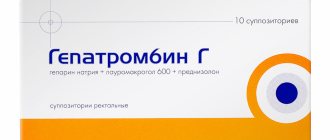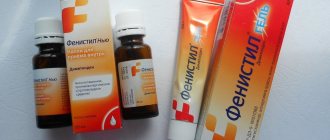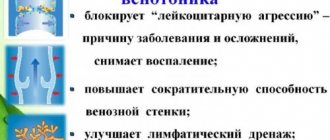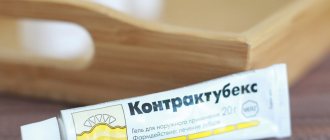Composition and dosage forms
Hepatrombin G contains several active components that complement each other’s effectiveness:
- heparin sodium: a direct anticoagulant that prevents the formation of blood clots;
- lauromacrogol 600: anesthetic agent with sclerosing effect;
- prednisolone: a glucocorticoid hormone with anti-inflammatory and antiallergic effects.
Gepatrombin G is produced in forms for topical use:
- Ointment: a viscous, homogeneous substance of light cream color with a waxy texture; in addition to active substances, it contains auxiliary and formative substances: paraffin, silicon dioxide. The ointment also contains lanolin, which accelerates tissue healing. The drug is packaged in 20 ml metal tubes equipped with special elongated tips for ease of use.
- Suppositories: torpedo-shaped rectal suppositories on a fat basis. Contains hard wax, triglycerides, silicon dioxide, glycerol and other form-building neutral substances. The drug is packaged in plates with individual cells, each containing 5 suppositories. There are 10 doses in one package of the drug.
How does Gepatrombin G work?
The drug is used in proctology to eliminate the main signs of exacerbation of hemorrhoids: irritation, swelling, pain, itching and burning. The effectiveness of the medicine is based on the components it contains:
- heparin reduces platelet activity, prevents the formation of blood clots in hemorrhoids, stimulates the regeneration of connective tissue, and promotes the healing of damage;
- prednisolone reduces inflammation, helps eliminate swelling, prevents the accumulation of exudate in the affected area, reduces pain and itching;
- lauromacrogol quickly relieves the burning sensation and helps in the regeneration of damaged epithelium.
The effect of the drug develops quickly. Within 10–15 minutes after application, acute pain and burning subsides. There is a pleasant feeling of coolness. On the first day of use, false urges to defecate and itching disappear. As treatment continues, swelling and unpleasant symptoms in the anorectal area decrease and then gradually disappear. At the same time, the risk of blood clots in the venous nodes is reduced, and they themselves decrease in size.
The components of Gepatrombin G are partially absorbed through the mucous membranes into the bloodstream. Their concentration in the body is insignificant to lead to systemic changes or health problems. The remains of the drug are transformed in the liver tissues, then excreted throughout the day through the kidneys.
Hemorrhoids in women. Treatment of hemorrhoids in pregnant women
How to treat hemorrhoids after giving birth?
Very often during pregnancy an unpleasant problem arises - hemorrhoids.
This is due to the fact that the uterus, which has significantly increased in size (especially in the second half of pregnancy), begins to put pressure on the pelvic area. This pressure on the vessels does not go unpunished - blood circulation is disrupted and blood stagnation occurs. This is what leads to the fact that the cavernous bodies of the final section of the rectum increase in size and form hemorrhoids.
Additional factors influencing the development of the disease are a decrease in a woman’s physical activity and the appearance of constipation. The intestines are not stimulated enough, peristalsis stops working normally. All this leads to further development of the disease, which is aggravated by childbirth.
Hemorrhoids after childbirth
After childbirth, the disease begins to bother the woman even more. Even if during pregnancy she managed to cope with acute attacks with the help of preventive measures, postpartum hemorrhoids require more serious treatment methods.
What does hemorrhoids look like in women after giving birth? During childbirth, there is a strong increase in intra-abdominal pressure, due to which increased blood flow begins to the blood vessels of the rectum. Hemorrhoids swell and come out. This becomes the reason that a woman recovering from childbirth is forced to deal with this problem as well.
During this period, a woman is most vulnerable and a special approach to therapy is required. If you do not start the disease, manage it correctly and do not self-medicate, the disease will go away forever.
Postpartum hemorrhoids often occur in an acute form - pain in the anus, difficulty in bowel movements, bleeding. You cannot ignore these symptoms - you should definitely consult a doctor who will tell you what to do.
Treatment of hemorrhoids after the birth of a child usually involves the use of conservative therapy. Special recommendations are aimed at helping a woman quickly recover and cope with the disease.
Hemorrhoids during lactation
During lactation it is not recommended to use surgical methods to treat the disease. Only conservative methods, soft preparations created specifically for women in labor and preventive measures.
As a rule, women are prescribed special suppositories and ointments that have anti-inflammatory and analgesic properties that soothe the itching and burning sensation of the bath. Despite the apparent ease of treatment, all these procedures should be prescribed only by a proctologist. Based on the woman’s condition and taking into account her situation, he will prescribe the necessary medications that will not harm either the mother or the baby.
To prevent constipation, which contributes to acute attacks, it is necessary to choose a balanced diet. It should contain coarse fiber, which will prevent constipation and stabilize stool. Increasing physical activity, special exercises to strengthen the pelvic muscles - all these methods will serve as the basis for stabilizing the condition.
For what diseases is Hepatrombin G indicated?
The drug is prescribed in the complex treatment of proctological pathologies:
- for internal, external and combined hemorrhoids;
- cracks in the anus of the rectum;
- thrombophlebitis of the anal veins;
- for eczema in the anal area, fistulas, itching and irritation of the mucous membrane.
According to user reviews, the drug Hepatrombin G in the form of an ointment helps well in resolving bruises and hematomas on the skin after injections. Before starting treatment, it is important to undergo diagnostics, eliminating possible contraindications.
When is it prohibited to use Gepatrombin G?
It is necessary to refuse therapy with suppositories and ointments:
- with reduced blood clotting, bleeding from the anus;
- oncological benign and malignant intestinal tumors;
- with infectious lesions of the rectum, the presence of parasites;
- for tuberculosis, syphilis;
- fungal, bacterial lesions of the skin and mucous membranes;
- in case of individual intolerance to the components of the drug.
Signs of a possible allergic reaction to Hepatrombin G: increased itching and severe burning a few hours after administration of the drug, sensation of a foreign object in the rectum, increased dryness of the mucous membrane.
Contraindications and side effects
It is forbidden to use hepatrombin gel if you are hypersensitive to the components in its composition. Hepatrombin gel is not prescribed to children under 5 years of age. There are also absolute contraindications for the 1st trimester of pregnancy. In subsequent periods of pregnancy and lactation, the product can be used for a short time only under medical indications.
The drug should also not be used for therapy:
- Skin lesions due to secondary infection.
- Open wounds.
The gel is used with extreme caution in the following cases:
- In case of liver and/or kidney failure.
- For palologies of the cardiovascular system.
- Bronchial asthma.
When using hepatrobin gel in accordance with the instructions and excluding all contraindications, adverse reactions of the body are rarely observed. Allergy risks appear only in case of hypersensitivity to the components in the drug. In such cases, there are risks of urticaria and angioedema.
How to use Gepatrombin G: instructions
It is necessary to use suppositories or a remedy in the form of an ointment at the first signs of exacerbation of the disease, choosing whichever is more convenient. In case of extensive damage to the rectum: deep fissures, internal and external hemorrhoids, it is recommended to use both types of drug simultaneously.
The product should be applied to a cleaned surface, preferably after defecation. Before using the ointment externally, it is recommended to wash the anal passage. If the disease is complicated by constipation, empty the intestines with an enema or laxative.
- The ointment should be applied to the affected areas in a thin layer. In case of deep inflammation, you can insert the tip of the tube into the rectum, squeezing out a little of the drug. In the first 1–2 days, the procedure should be repeated 2–3 times a day. When the symptoms of exacerbation subside, it is enough to use the ointment once a day.
- The suppositories must be inserted into the anus to a depth of 2–4 cm, without wetting them with anything. To ensure that the effect of the medicine lasts as long as possible, it is recommended to lie down for 15–20 minutes. You can use suppositories before bed. Treatment should be repeated 2-3 times a day until the symptoms of the disease decrease.
The course of use of the drug Gepatrombin G is about a week. Longer treatment is undesirable, as it can cause hormonal imbalance.
Hepatrombin
The drug hepatrombin from the Serbian pharmaceutical is a drug that has antithrombotic and anti-inflammatory effects, and also promotes tissue restoration after various types of damage. It is used for the treatment and prevention of thrombosis, thrombophlebitis (when inflammation of the venous wall is associated with thrombosis), varicose veins and a number of other “same-root” diseases. Hepatrombin is a combined drug, the properties of which are determined by the capabilities of each of its components, of which, if we count only “passionary” pharmacologically active substances, there are three, namely: heparin, allantoin and dexpanthenol. Heparin is a direct anticoagulant belonging to the group of medium molecular heparins. It does all the work to counteract blood clotting with the “hands” of antithrombin III, activating it and prompting it to action. Heparin disrupts the transition of prothrombin to thrombin, suppresses the activity of thrombin and activated X factor. When applied topically, it inhibits the processes of thrombus formation, has an anti-inflammatory and anti-edematous effect, and stimulates blood flow in the microcirculatory bed. Allantoin is an astringent (in relation to the skin it would be more correct to say contracting) and keratolytic (softening and rejecting the stratum corneum of the epidermis) agent. It has an anti-inflammatory effect, stimulates the processes of tissue metabolism, tissue regeneration, and promotes cell reproduction. It is often used in various pharmacological combinations for the treatment of skin diseases, hemorrhoids, erosive and ulcerative lesions in the anus, and lesions of the oral mucosa. And the last active component of hepatrombin is dexpanthenol: it is a derivative of pantothenic acid and belongs to the B vitamins.
The processes of acetylation and oxidation cannot occur without dexpanthenol. It also participates in the metabolism of fats and carbohydrates, the synthesis of corticosteroids, acetylcholine, and porphyrins. Plays an important role in the formation and functioning of epithelial tissue (stimulates the processes of granulation and epithelization), promotes the rapid absorption of heparin from the surface of the skin. Has a weak anti-inflammatory effect.
Hepatrombin is available in two dosage forms: ointment and gel for external use. After local application of any of these dosage forms to the affected areas of the skin, heparin quickly enough (with the help of dexpanthenol) penetrates the epidermis and accumulates in the outer layers of the skin, actively binding to skin proteins. It is excreted from tissues extremely reluctantly; its excretion period is about 1 hour. Hepatrombin in the form of an ointment is used as follows: a column of the substance 5 cm long is applied to the affected area of the skin 1-3 times a day. For diseases of the veins, hepatrombin is used in the form of bandages with ointment applied to them. For trophic ulcers, the ointment should be applied not to the affected area itself, but around it in a ring about 4 cm wide. If the veins of the legs are affected, then the ointment should be applied with light movements (as with a massage) in the direction from bottom to top, and a single dose is not used immediately, but in separate portions. Now about the gel: it should be applied in a thin layer, rubbing in, as in the case of ointment, from bottom to top with light massaging movements. The only exception is thrombosis and thrombophlebitis, when massage must be abandoned. Unlike ointment, the gel contains essential oils - oil of mountain pine and Scots pine needles, as well as lemon oil. This “bonus” gives hepatrombin gel an additional antibacterial and analgesic effect.




